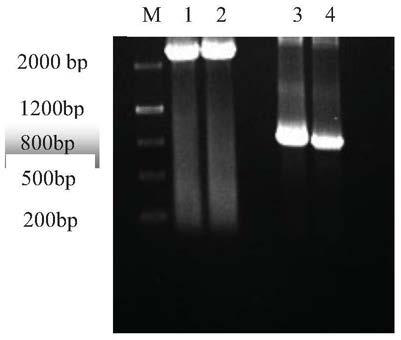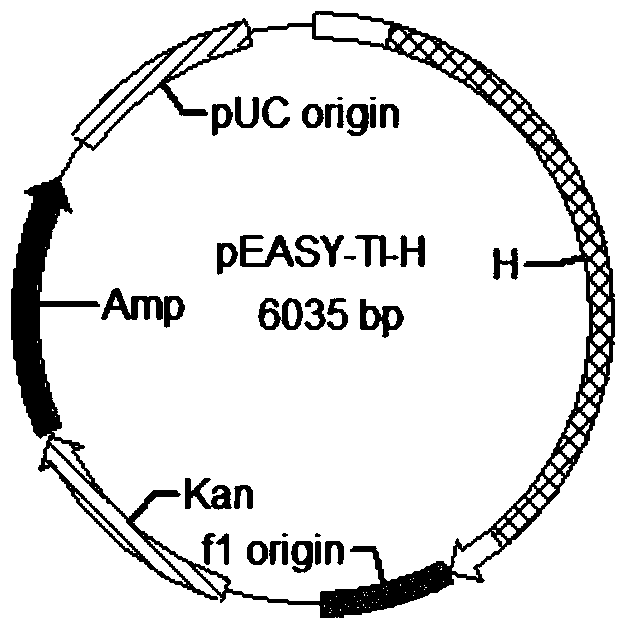Anti-p185erbb2 human-mouse chimeric antibody chab26, mammary gland-specific expression vector, transgenic fvb mouse and preparation method thereof
A p185erbb2, human-mouse chimeric antibody technology, applied in the field of bioengineering, can solve the problems of high treatment costs and high production costs for tumor patients, and achieve the effects of avoiding anti-antibody reactions, low cost, and easy scale-up
- Summary
- Abstract
- Description
- Claims
- Application Information
AI Technical Summary
Problems solved by technology
Method used
Image
Examples
Embodiment 1
[0071] Example 1 Anti-p185 erb B2 Construction of mammary gland-specific expression vector of human-mouse chimeric antibody ChAb26 transgenic mouse
[0072] 1. Obtaining the target gene
[0073] anti-p185 erbB2 The pUC57 / pBCN-H-F2A-L-ployA-EGFP-Neo plasmid of the human-mouse chimeric antibody ChAb26 heavy chain H and light chain gene L was used as a template ( figure 1 ), under the action of LA Taq DNA polymerase, respectively H-F / H-R (SEQ.ID.NO.1 / SEQ.ID.NO.2) and L-F / L-R (SEQ.ID.NO.4 / SEQ.ID. NO.5) Amplify anti-p185 for primers erb B2 Human-mouse chimeric antibody ChAb26 heavy chain gene H (SEQ.ID.NO.3) and light chain gene L (SEQ.ID.NO.6). After identification by 1% agarose gel electrophoresis, the specific bands of the heavy chain gene H and the light chain gene L were consistent with the theoretical values, and the sizes were 2113bp and 799bp ( figure 2 ).
[0074] The amplification primer of table 1 target gene (the underlined part is the sequence of restriction end...
Embodiment 2
[0101] Example 2 Anti-p185 erbB2 Preparation of human-mouse chimeric antibody ChAb26 transgenic FVB mice
[0102] 1. Anti-p185 erbB2 Linearization of human-mouse chimeric antibody mammary gland-specific expression vector pBC1-H / pBC1-L
[0103] The anti-p185 constructed in Example 1 was digested with Sal I and Not I endonucleases erbB2 The human-mouse chimeric antibody ChAb26 mammary gland-specific expression plasmid pBC1-H / pBC1-L was linearized, and the results were as follows Figure 23 with Figure 24 shown. Mammary gland-specific expression plasmids pBC1-H (23735bp) or pBC1-L (22421bp) were linearized into pBC1-H-linear fragments (17861bp, SEQ. ID.NO.11) or pBC1-L-linear fragment (16547bp, SEQ.ID.NO.12).
[0104] 2. Preparation of transgenic mice by microco-injection
[0105] With the assistance of Saiye (Suzhou) Biotechnology Co., Ltd., the linearized mammary gland-specific expression plasmids pBC1-H-linear and pBC1-L-linear were diluted to an appropriate concentrat...
Embodiment 3
[0124] Example 3 Anti-p185 erbB2 Acquisition and identification of human-mouse chimeric antibody ChAb26
[0125] 1. Anti-p185 erbB2 Acquisition of human-mouse chimeric antibody ChAb26
[0126] 10 days after the pregnant mice gave birth, use the mouse milker (WAT 2006) to collect milk from the transgenic mother mice (lactating period); then transfer the milk collected in the collection tubes to sterilized Ep tubes, 4°C, 4000× Centrifuge at g for 20 minutes; after centrifugation, the milk is divided into three layers, the upper layer is milky white milk fat, the lower layer is insoluble matter, and the middle layer is clear liquid. Use a 1ml disposable syringe to pierce the Ep tube at the lower edge of the middle layer, and gently suck out the clear liquid in the middle layer, which is anti-p185 erbB2 Human mouse chimeric antibody ChAb26 solution.
[0127] 2. Western blot detection of the expression of chimeric antibody ChAb26 in the milk of transgenic double-positive mice ...
PUM
 Login to View More
Login to View More Abstract
Description
Claims
Application Information
 Login to View More
Login to View More - R&D
- Intellectual Property
- Life Sciences
- Materials
- Tech Scout
- Unparalleled Data Quality
- Higher Quality Content
- 60% Fewer Hallucinations
Browse by: Latest US Patents, China's latest patents, Technical Efficacy Thesaurus, Application Domain, Technology Topic, Popular Technical Reports.
© 2025 PatSnap. All rights reserved.Legal|Privacy policy|Modern Slavery Act Transparency Statement|Sitemap|About US| Contact US: help@patsnap.com



